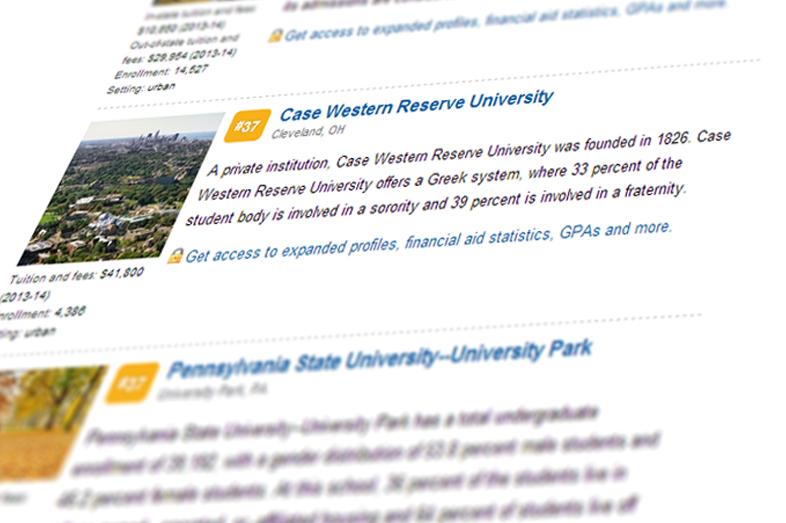Rankings – why they should matter to you
September 20, 2013
Last week, the U.S. News and World Report released its annual national college ranking list. While the number one on the list may have surprised some, the changes were not as earth-shattering here in Northeastern Ohio. In fact, there were none: Case Western Reserve kept its spot as 37th in the nation from last year.
However, there were a few results included in that ranking that call for closer attention. As the Daily reported on Sept. 10, CWRU went up in undergraduate participation and admissions, and down in graduation and retention. The average retention rate was reported to be 92 percent while the six-year graduation rate was 78 percent. Why is it that CWRU seems to be struggling from the same issues year after year? Is anyone doing anything about it? More importantly, do these rankings even matter?
As a regular student, it may be easy to point out problems on our campus, but it is not so easy to identify which ones of those reasons are actually the causes of poor national rankings. A quick look at the results of last year’s CWRU senior survey shows that students expressed slight dissatisfaction in categories “sense of community on campus” (36 percent were dissatisfied) and “student voice in university policies” (40 percent were dissatisfied). It also tells that while 81 percent of the students surveyed are satisfied with their undergraduate experience, only 60 percent would “definitely/probably attend CWRU again.” There it is again – retention.
The reality is, however, that the U.S. News and World Report ranking is not based on senior surveys – it is based on just a number. But what is that number based on? What are the reasons behind low retention rates? The truth lies just in the fact that there are multiple reasons, not just one. It is difficult to pinpoint why that one student from your freshman calculus class decided to go elsewhere for their second year of college. Perhaps they got homesick and wanted to go to school closer to home; perhaps their financial situation was so tight that they had to move to a less expensive school.
Another piece of information that the U.S. News and World Report will not tell us is that universities heavily oriented toward science and technology often tend to have lower retention and four-year graduation rates. This is mostly due to the fact that many first-year engineering and science students realize mid-year that they would like to switch fields. At a university like CWRU, the temptation to transfer to a well-known liberal arts school may be higher than studying humanities here. The science orientation of CWRU also affects the graduation rates. Our low graduation rankings are partly due to the fact that many engineering and business students do co-ops and practicums, which can delay their graduation by a semester. The rankings must be put in perspective or else we cannot actually understand how they reflect on our university.
In any case, CWRU should do something about the retention issue, and it has. As it happens, in 2012, the university reformed its freshman experience program. In practice, this means that the administrators are taking a softer view on how to treat the students. Whether it means showing first-year students how to navigate around Cleveland using public transportation or combining the services of the office of undergraduate studies with those of residence life, some major changes have been made. And they are bearing fruit. In fact, the most recent freshman retention rate, published this last Monday, is a staggering 94.3 percent – higher than it has been in a long time. In general, the administration has taken steps toward a more individual-oriented approach where the students’ needs are given more personalized attention.
While rankings are all interesting pieces of information, they do not really reflect on what kind of an institution CWRU is. The fact that CWRU’s retention and graduation rankings went down from last year does not mean that we go to a bad school. Rather, the lower rankings are a reflection of a potential problem within the university. They are merely indicators for areas for improvement. And we certainly are improving.
Rankings should not be taken completely seriously. They are imperative in terms of recruiting but for the average student, it does not matter whether CWRU placed 37th in the nation or not. However, rankings are a good source to use to point out areas where the university should improve. The fact that CWRU’s retention and graduation rankings have historically been on the low side is bad, but the fact that the administration finally took the first steps to fix the problems is very promising. Hopefully, the satisfaction percentages on the senior surveys of the future will look much more uplifting than they do now.
The editorial opinion takes a stand on a select campus issue that The Observer’s board of directors, the executive committee of the editorial board, considers relevant and consequently should be brought to the attention of the Case Western Reserve University community. The board consists of the executive editor and publisher, director of design, director of web and multimedia, director of print, director of business and marketing, and opinion editor. A member of the board meets with students, staff, faculty or any other persons who the board considers to be a subject matter expert. The board will then decide what stance to take on the issue, or if there are disagreements among the members, communicate them in the editorial. The meetings with interviewees occur off the record; no person will be directly quoted or referred to by their name. The editorial opinion does not in any way influence the work of the editors, reporters and staff of The Observer, nor does it represent the opinions of those interviewed for it.


